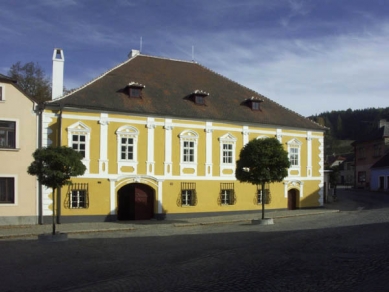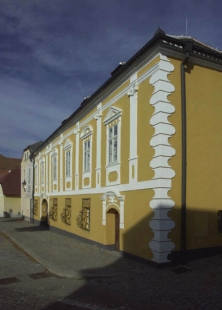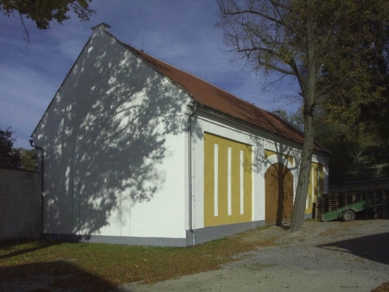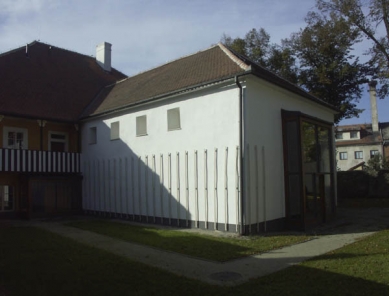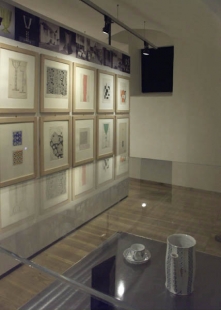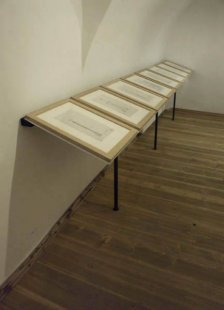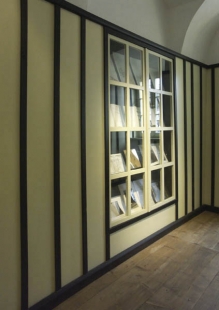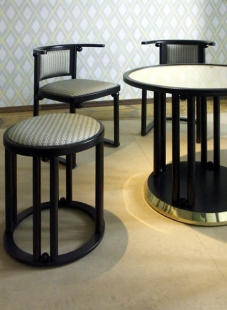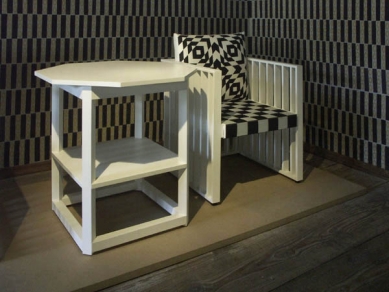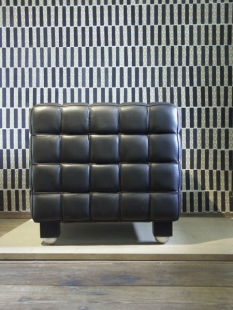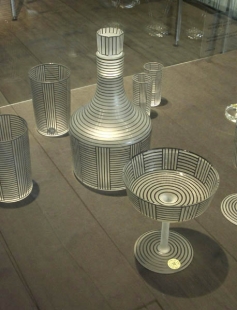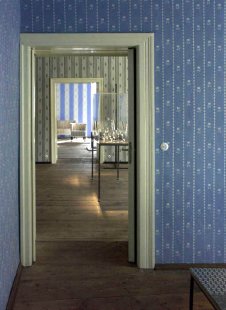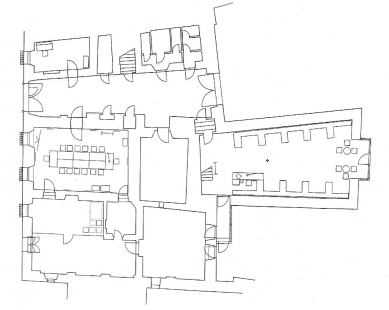
Reconstruction and modification of the birthplace of Josef Hoffmann

The aim of the proposal was to restore the building to a condition that would resemble the appearance of the house after the modifications made by Josef Hoffman in 1911, and further to adjust the object for the function of a cultural center for the town of Brtnice, i.e., as a memorial to Josef Hoffman and simultaneously as a public library and an informational, exhibition, and lecture center.
The reconstruction of the state from 1911 was carried out on the preserved parts of the main building - the baroque roof destroyed in a fire in the 1930s and the bricked gallery on the northern side of the garden facade that was torn down in the 1970s were not restored. The reconstruction also meant the restoration of the baroque appearance of the front facade, which had been destroyed in the 1970s under the supervision of heritage preservation due to the replacement of windows on both floors. The most striking element of the reconstruction is the painting of the interiors on the first floor, where a painting according to Hoffmann's design was discovered, uncovered, and restored beneath newer coats.
In these spaces, a permanent exhibition of Josef Hoffmann's work is to be installed in the future. The operation of the building was initiated by the exhibition "Josef Hoffmann - Timeless Design," which presents pieces of furniture and applied art objects that are still in production according to Hoffmann's original designs. The public library (before reconstruction located on the upper floor) has been newly placed in the economic wing of the building, which has been extensively modified for these purposes, and in part of the ground floor. The building also included adjustments to the garden area. For the overall dignified and meaningful rehabilitation of Josef Hoffmann's birthplace in Brtnice, it remains to remove the brutally built repair hall in the unrenovated part of the garden and complete its restoration, as well as reconstruct the original barn and the wooden garden pavilion designed by Hoffmann, which is projectually prepared.
RECONSTRUCTION, CONVERSION
The Brtnice Society of Josef Hoffmann obtained resources from the Sapard program as well as the town of Brtnice and set itself the goal of building a monument and a permanent exhibition of the artist's work in this house, and moreover to rehabilitate it as a public library. The project was developed by the team Petr Hrůša - Petr Pelčák. For the preserved parts of the house, they aimed for a return to the artistically most valuable phase, namely the state immediately after Hoffmann's modifications. They thus had to restore the baroque facade, which the Master once repaired with care, but which had later been damaged. Because his interventions were soon published (in the magazine Das Interieur), it was possible to reconstruct their non-preserved parts. However, the building was also successfully adapted to another, non-original function. The seat of the regional library was newly located in the economic wing. The reconstruction of the hall with an internal gallery respected its original volume and took over the wooden structure, along with the sensory qualities of the material – it smells wonderful. But it was the tall windows, which from the inside appear to stretch across the full height of the former two-story stable, that confirm the new purpose of the object: they create a dignified library hall. Furthermore, the children's section found a place on the ground floor of the main building with a clever view into the vaulted cellar, and it was also possible to lead entrances to the new parts of the entire complex directly from the house passage. The authors did not avoid a number of decisions during the reconstruction of the Brtnice house, supported by considerations about the originality of individual elements, and thus immensely strengthened the message of the future museum. Unfortunately, last year, the Society of Josef Hoffmann was forced to suspend work due to lack of funds. The Master's own room became a kind of memorial with the remaining original furnishings; however, the opening of the permanent exhibition was postponed to 2005.
EXHIBITION
In this situation, the chairwoman of the Society of Josef Hoffmann, Eliška Nosálová, approached the director of the Austrian Cultural Forum, Walter Persché, with the idea of presenting the artist's work alongside products from Austrian companies that still use his designs for production or have purchased them from his estate. With his support and in collaboration with Dr. Dagmar Koudelková, this year's exhibition was created. In a sparsely designed exhibition, whose effect Petr Pelčák built on the contrast between restored paintings, uncovered old floors, and simple showcases on steel legs, objects were gathered that demonstrate the current impressiveness (and marketability) of Hoffmann's designs. Backhausen, which has been using its probably largest collection of original textile designs since 1970, regularly changes the exhibition of textiles produced according to the artist's patterns in the Brtnice house, thanks to Petr Backhausen, who created the corporate museum of Wiener Werkstätte products in Vienna. The J. & L. Lobmeyr company provided several beverage sets produced according to the artist's designs from the years 1912-1918. The oldest Austrian porcelain factory, Augarten, now produces younger Hoffmann tableware. Wolfgang Karolinsky, founder of the WOKA LAMPS® company, which creates precise replicas of lighting fixtures by leading modernist creators, supplied several Hoffmann lamps. Also exhibited is a master work from the glass workshop of Petr Rath, executed according to the author's unrealized design. However, the most significant contribution to the exhibition comes from DK Heinz F. Hofer-Wittmann, who purchased most of Hoffmann's furniture designs, including construction sketches, for his family business in the 1960s and manufactures them in a series titled REKREACION HOFFMANN. Designers collaborating with the Wittmann company, such as Paolo Piva or Adolf Krischanitz, further develop Hoffmann's style in their works.
HOFFMANN TODAY
Today’s production of Hoffmann's furniture reveals a certain paradox. The excitement of the architect's youth for Ruskin's and Morris's ideals of refining humanity with noble objects led him to insist on small-scale handcrafted production of his designs until the end of his life, which probably also resulted in the decline of the Wiener Werkstätte. Hoffmann would never have identified himself with the statements of his classmate from the Brno gymnasium, Adolf Loos, that "a good copy is as good as the original." Modernists ultimately corroborated Loos's viewpoint, as in 1913, in the crucial dispute over the teaching of design, Behrens triumphed over Van de Velde, and the artistic craft gradually gave way to industrial design in the focus of architects' interest. Hoffmann became, for many, a decorator of exclusive interiors, and even today it is often forgotten that he began addressing the issue of social housing in the 1920s and designed the Kunsthalle for Vienna in 1928, coming close to the style of Mies van der Rohe. His reclining chair Sitzmaschine from 1905 became a template for functionalist furniture and, like other Hoffmann's designs, also became the subject of one of the first machine productions of furniture by the company J. & J. Kohn, a competitor of the more famous Thonet. The austerity of the artist's geometric period of the 1910s was driven by an aesthetic need for a new style, and thus was not founded ethically as with Loos. Hoffmann was always able to temper his overflowing creativity and fascination with decoration with a natural sense of practicality and comfort - thus achieving a balance characteristic of timeless design, and in doing so, he enabled his designs to have a "second life" in today’s production. The institution of the museum establishes the concept of the irreplaceable original - the future Hoffmann Museum in Brtnice could not prepare its future visitors better than with an exhibition that not only introduces the perfect style of Josef Hoffmann but also reflects on authenticity, the original, and its contemporary meaning.
The reconstruction of the state from 1911 was carried out on the preserved parts of the main building - the baroque roof destroyed in a fire in the 1930s and the bricked gallery on the northern side of the garden facade that was torn down in the 1970s were not restored. The reconstruction also meant the restoration of the baroque appearance of the front facade, which had been destroyed in the 1970s under the supervision of heritage preservation due to the replacement of windows on both floors. The most striking element of the reconstruction is the painting of the interiors on the first floor, where a painting according to Hoffmann's design was discovered, uncovered, and restored beneath newer coats.
In these spaces, a permanent exhibition of Josef Hoffmann's work is to be installed in the future. The operation of the building was initiated by the exhibition "Josef Hoffmann - Timeless Design," which presents pieces of furniture and applied art objects that are still in production according to Hoffmann's original designs. The public library (before reconstruction located on the upper floor) has been newly placed in the economic wing of the building, which has been extensively modified for these purposes, and in part of the ground floor. The building also included adjustments to the garden area. For the overall dignified and meaningful rehabilitation of Josef Hoffmann's birthplace in Brtnice, it remains to remove the brutally built repair hall in the unrenovated part of the garden and complete its restoration, as well as reconstruct the original barn and the wooden garden pavilion designed by Hoffmann, which is projectually prepared.
author's report
The Second Life of Josef Hoffmann
Josef Hoffmann (1870-1956), an Austrian architect, a key figure of the first generation of modernism, always enjoyed returning to his hometown Pirnitz - Brtnice near Jihlava. Moravia was, from the beginning, a source of folkloristic inspiration for him as "... a dreamy land of fairy tales, an eternal homeland for us despite all violence, hardships, and suffering," but eventually also a land that provided him with opportunities to develop his concept of the villa suburbana after the Austrian center ceased to show interest in such buildings. The baroque house on the Brtnice square, where the Hoffmann family lived for several generations, was modified by the architect between 1907 and 1911 (i.e., at the time when he was completing the Stocklet Palace in Brussels) for summer stays of his family and sisters. In the ground floor, he set up a private room, each room on the first floor was enhanced with a different stencil painting, and its older furnishings were complemented with objects from the production of the Wiener Werkstätte; in the southern part of the house, he designed a gallery and converted a hayloft into a garden gazebo. However, after 1945, he never returned to his birthplace.RECONSTRUCTION, CONVERSION
The Brtnice Society of Josef Hoffmann obtained resources from the Sapard program as well as the town of Brtnice and set itself the goal of building a monument and a permanent exhibition of the artist's work in this house, and moreover to rehabilitate it as a public library. The project was developed by the team Petr Hrůša - Petr Pelčák. For the preserved parts of the house, they aimed for a return to the artistically most valuable phase, namely the state immediately after Hoffmann's modifications. They thus had to restore the baroque facade, which the Master once repaired with care, but which had later been damaged. Because his interventions were soon published (in the magazine Das Interieur), it was possible to reconstruct their non-preserved parts. However, the building was also successfully adapted to another, non-original function. The seat of the regional library was newly located in the economic wing. The reconstruction of the hall with an internal gallery respected its original volume and took over the wooden structure, along with the sensory qualities of the material – it smells wonderful. But it was the tall windows, which from the inside appear to stretch across the full height of the former two-story stable, that confirm the new purpose of the object: they create a dignified library hall. Furthermore, the children's section found a place on the ground floor of the main building with a clever view into the vaulted cellar, and it was also possible to lead entrances to the new parts of the entire complex directly from the house passage. The authors did not avoid a number of decisions during the reconstruction of the Brtnice house, supported by considerations about the originality of individual elements, and thus immensely strengthened the message of the future museum. Unfortunately, last year, the Society of Josef Hoffmann was forced to suspend work due to lack of funds. The Master's own room became a kind of memorial with the remaining original furnishings; however, the opening of the permanent exhibition was postponed to 2005.
EXHIBITION
In this situation, the chairwoman of the Society of Josef Hoffmann, Eliška Nosálová, approached the director of the Austrian Cultural Forum, Walter Persché, with the idea of presenting the artist's work alongside products from Austrian companies that still use his designs for production or have purchased them from his estate. With his support and in collaboration with Dr. Dagmar Koudelková, this year's exhibition was created. In a sparsely designed exhibition, whose effect Petr Pelčák built on the contrast between restored paintings, uncovered old floors, and simple showcases on steel legs, objects were gathered that demonstrate the current impressiveness (and marketability) of Hoffmann's designs. Backhausen, which has been using its probably largest collection of original textile designs since 1970, regularly changes the exhibition of textiles produced according to the artist's patterns in the Brtnice house, thanks to Petr Backhausen, who created the corporate museum of Wiener Werkstätte products in Vienna. The J. & L. Lobmeyr company provided several beverage sets produced according to the artist's designs from the years 1912-1918. The oldest Austrian porcelain factory, Augarten, now produces younger Hoffmann tableware. Wolfgang Karolinsky, founder of the WOKA LAMPS® company, which creates precise replicas of lighting fixtures by leading modernist creators, supplied several Hoffmann lamps. Also exhibited is a master work from the glass workshop of Petr Rath, executed according to the author's unrealized design. However, the most significant contribution to the exhibition comes from DK Heinz F. Hofer-Wittmann, who purchased most of Hoffmann's furniture designs, including construction sketches, for his family business in the 1960s and manufactures them in a series titled REKREACION HOFFMANN. Designers collaborating with the Wittmann company, such as Paolo Piva or Adolf Krischanitz, further develop Hoffmann's style in their works.
HOFFMANN TODAY
Today’s production of Hoffmann's furniture reveals a certain paradox. The excitement of the architect's youth for Ruskin's and Morris's ideals of refining humanity with noble objects led him to insist on small-scale handcrafted production of his designs until the end of his life, which probably also resulted in the decline of the Wiener Werkstätte. Hoffmann would never have identified himself with the statements of his classmate from the Brno gymnasium, Adolf Loos, that "a good copy is as good as the original." Modernists ultimately corroborated Loos's viewpoint, as in 1913, in the crucial dispute over the teaching of design, Behrens triumphed over Van de Velde, and the artistic craft gradually gave way to industrial design in the focus of architects' interest. Hoffmann became, for many, a decorator of exclusive interiors, and even today it is often forgotten that he began addressing the issue of social housing in the 1920s and designed the Kunsthalle for Vienna in 1928, coming close to the style of Mies van der Rohe. His reclining chair Sitzmaschine from 1905 became a template for functionalist furniture and, like other Hoffmann's designs, also became the subject of one of the first machine productions of furniture by the company J. & J. Kohn, a competitor of the more famous Thonet. The austerity of the artist's geometric period of the 1910s was driven by an aesthetic need for a new style, and thus was not founded ethically as with Loos. Hoffmann was always able to temper his overflowing creativity and fascination with decoration with a natural sense of practicality and comfort - thus achieving a balance characteristic of timeless design, and in doing so, he enabled his designs to have a "second life" in today’s production. The institution of the museum establishes the concept of the irreplaceable original - the future Hoffmann Museum in Brtnice could not prepare its future visitors better than with an exhibition that not only introduces the perfect style of Josef Hoffmann but also reflects on authenticity, the original, and its contemporary meaning.
Lukáš Beran (written for the magazine ARCHITEKT 8/2004)
The English translation is powered by AI tool. Switch to Czech to view the original text source.
1 comment
add comment
Subject
Author
Date
add krásno ..
Kranich
05.10.06 09:09
show all comments


